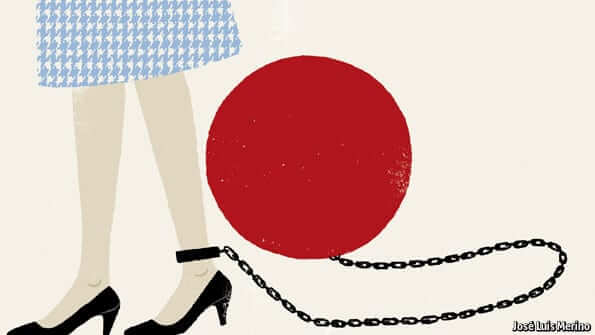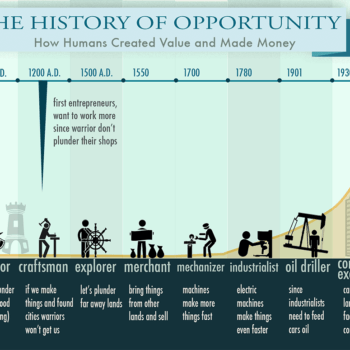The Japanese government wants more women to participate in the workforce. In fact, following December 2014 elections, one the new government’s slogans has become “Women Will Revitalize Japan (女性が輝く日本).”
While this may seem like a victory for gender equity in what has traditionally been a male-dominated society, many Japanese women are worried they are simply being asked to do more for less.
Just 65% of women aged 15 to 64 are employed in Japan, compared to nearly 85% of Japanese men. According to an August 2014 U.S. Congressional Research Service report that investigated Japan’s gender gap:
In the World Economic Forum’s Global Gender Gap Report 2013, which measures and tracks gender-based disparities on a number of dimensions, such as labor force participation and compensation, Japan ranked 105th out of 135 countries, just below Cambodia and above Nigeria.
In comparison, the United States ranked 23rd. Several low- and middle-income countries ranked above Japan, such as Azerbaijan, Burkina Faso, China, India, Malaysia, and Russia. The only high-income countries ranked lower than Japan include South Korea and some countries in the Middle East.
In most OECD countries, the participation rate of university-educated women stood between 70% and 90% in 2013.
Besides the implication that Japan lags far behind its peers in terms of gender equity in the workplace and society in general, an ongoing demographic shift means Japan is running out of workers to support an ageing population.
Japan’s total population is projected to shrink by around 30% by 2055 as the number of births falls to 40% of the 2005 level. The proportion of elderly doubles, and the working age population halves.
A 2010 Goldman Sachs report estimated that if women in Japan were employed at the same rate as men (about 80% of working age-men in Japan are employed, according to Goldman Sachs’ research) Japan’s economic output would grow by up to 15%.
The Japanese government, led by Prime Minister Shinzo Abe, is making the promotion of women’s empowerment (女性活躍推進, joseikatsuyakusuishin) and “womenomics” a priority to not only increase tax revenues, but also to spur consumer demand and ignite inflation.
More work, even less free time
But is there a genuine will to improve the status of women in the workplace?
In a recent column Kotaro Tamura, a former (male) member of Japan’s national Diet and parliamentary secretary to Japanese Prime Minister Abe, writes in business magazine Mag2 News about the need to provide women with adequate childcare if they are to enter the workforce:
Japanese women, however, are not so sure that being asked to join the workforce is such a good thing.
The fear expressed by Japanese women is that on top of childcare, running a household and caring for aging parents, Japanese women will also be expected to work full-time.
Maiko Kissaka, a noted (female) designer and freelance columnist, writes:
According to Kissaka, this may be unrealistic:
For Japanese women, “womenomics” simply means more work and even less free time than they already have at present.
Others are asking if Japan even has enough quality work right now for woman who wish to enter the workforce.
In an online interview, researcher Daisuke Suzuki, author of the Japanese-language book “The Poorest Girls” (最貧困女子), says that one in three single women in Japan earn less than ¥1.14 million (US$9,000), below Japan’s poverty threshold of ¥1.22 million (US$10,000).
One reason is because fewer than half of female high school graduates in Japan can obtain full-time work. As well, 80% of single mothers in Japan live in poverty.
Because of high female poverty rates in Japan, Suzuki and others say, a considerable amount of young woman must rely on the sex trade to earn a living (a Japanese-language documentary of the phenomenon can be viewed here).
‘Abe has no idea of women’s backbreaking struggles’
Skepticism of the Abe government’s push for womenomics, along with the slogan “Women Will Revitalize Japan” has erupted into the mainstream.
A recent feature story in the Mainichi newspaper reports on what a variety of glossy women’s weekly tabloid-style magazines are actually saying about the Abe government’s plans for women in Japan:
Glossy weeklies usually devoted to celebrity gossip and beauty tips have been standing out recently for their sharp criticism of the Abe government.
What is the target of their wrath? The Abe government’s core policies of revising Article 9 of the constitution, Abenomics, and empowering women.
We take a look at the source of all this anger.
– Mainichi Shimbun Digital Edition
Mainichi writer Yoshiaki Kobayashi starts off his article by examining three leading weekly magazines aimed primarily at Japanese women: Josei7 (女性セブン, “Women’s Weekly”), Josei Jishin (女性自身, “Women’s Own”) and Shukan Josei (週刊女性, “Weekly Woman”).
Kobayashi notes they carry a strong anti-Abe sentiment:
Kobayashi suggests that ever since the March 2011 “Triple Disaster” in Tohoku, when a massive earthquake, tsunami and nuclear accident ravaged Japan’s northeast coastline, there has been an upswell in criticism of the Japanese government.
But even if the government manages to win over the women of the nation, Japan’s society itself must change.
As HR consultant Junko Tanaka tweets:
If we’re really going to take “women’s empowerment” seriously, we have to ditch the whole concept of a “rulebook” for handling female employees. Would you say the same thing about a male employee?
The Japanese government wants more women to participate in the workforce. In fact, following December 2014 elections, one the new government’s slogans has become “Women Will Revitalize Japan (女性が輝く日本).”
While this may seem like a victory for gender equity in what has traditionally been a male-dominated society, many Japanese women are worried they are simply being asked to do more for less.
Just 65% of women aged 15 to 64 are employed in Japan, compared to nearly 85% of Japanese men. According to an August 2014 U.S. Congressional Research Service report that investigated Japan’s gender gap:
In the World Economic Forum’s Global Gender Gap Report 2013, which measures and tracks gender-based disparities on a number of dimensions, such as labor force participation and compensation, Japan ranked 105th out of 135 countries, just below Cambodia and above Nigeria.
In comparison, the United States ranked 23rd. Several low- and middle-income countries ranked above Japan, such as Azerbaijan, Burkina Faso, China, India, Malaysia, and Russia. The only high-income countries ranked lower than Japan include South Korea and some countries in the Middle East.
In most OECD countries, the participation rate of university-educated women stood between 70% and 90% in 2013.
Besides the implication that Japan lags far behind its peers in terms of gender equity in the workplace and society in general, an ongoing demographic shift means Japan is running out of workers to support an ageing population.
Japan’s total population is projected to shrink by around 30% by 2055 as the number of births falls to 40% of the 2005 level. The proportion of elderly doubles, and the working age population halves.
A 2010 Goldman Sachs report estimated that if women in Japan were employed at the same rate as men (about 80% of working age-men in Japan are employed, according to Goldman Sachs’ research) Japan’s economic output would grow by up to 15%.
The Japanese government, led by Prime Minister Shinzo Abe, is making the promotion of women’s empowerment (女性活躍推進, joseikatsuyakusuishin) and “womenomics” a priority to not only increase tax revenues, but also to spur consumer demand and ignite inflation.
More work, even less free time
But is there a genuine will to improve the status of women in the workplace?
In a recent column Kotaro Tamura, a former (male) member of Japan’s national Diet and parliamentary secretary to Japanese Prime Minister Abe, writes in business magazine Mag2 News about the need to provide women with adequate childcare if they are to enter the workforce:
Japanese women, however, are not so sure that being asked to join the workforce is such a good thing.
The fear expressed by Japanese women is that on top of childcare, running a household and caring for aging parents, Japanese women will also be expected to work full-time.
Maiko Kissaka, a noted (female) designer and freelance columnist, writes:
According to Kissaka, this may be unrealistic:
For Japanese women, “womenomics” simply means more work and even less free time than they already have at present.
Others are asking if Japan even has enough quality work right now for woman who wish to enter the workforce.
In an online interview, researcher Daisuke Suzuki, author of the Japanese-language book “The Poorest Girls” (最貧困女子), says that one in three single women in Japan earn less than ¥1.14 million (US$9,000), below Japan’s poverty threshold of ¥1.22 million (US$10,000).
One reason is because fewer than half of female high school graduates in Japan can obtain full-time work. As well, 80% of single mothers in Japan live in poverty.
Because of high female poverty rates in Japan, Suzuki and others say, a considerable amount of young woman must rely on the sex trade to earn a living (a Japanese-language documentary of the phenomenon can be viewed here).
‘Abe has no idea of women’s backbreaking struggles’
Skepticism of the Abe government’s push for womenomics, along with the slogan “Women Will Revitalize Japan” has erupted into the mainstream.
A recent feature story in the Mainichi newspaper reports on what a variety of glossy women’s weekly tabloid-style magazines are actually saying about the Abe government’s plans for women in Japan:
Glossy weeklies usually devoted to celebrity gossip and beauty tips have been standing out recently for their sharp criticism of the Abe government.
What is the target of their wrath? The Abe government’s core policies of revising Article 9 of the constitution, Abenomics, and empowering women.
We take a look at the source of all this anger.
Kobayashi notes they carry a strong anti-Abe sentiment:
Kobayashi suggests that ever since the March 2011 “Triple Disaster” in Tohoku, when a massive earthquake, tsunami and nuclear accident ravaged Japan’s northeast coastline, there has been an upswell in criticism of the Japanese government.
But even if the government manages to win over the women of the nation, Japan’s society itself must change.
This article by Nevin Thompson originally appeared on Global Voices on April 23, 2015.





























